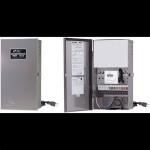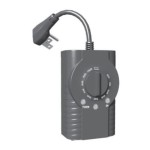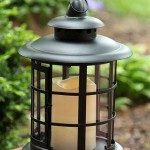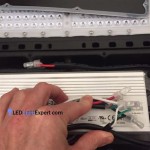Outdoor LED Spotlight with Photocell Sensor: Illuminating Efficiency and Automation
Outdoor LED spotlights equipped with photocell sensors represent a significant advancement in exterior lighting solutions. These devices combine the energy efficiency of Light Emitting Diode (LED) technology with the convenience of automated operation, resulting in cost-effective, reliable, and environmentally conscious illumination for a variety of outdoor applications. Understanding the components, functionalities, advantages, and considerations involved in selecting and installing these spotlights is crucial for maximizing their benefits.
The core function of an outdoor LED spotlight with a photocell sensor is to provide targeted, bright light to specific areas of a property. This can include illuminating pathways, highlighting architectural features, enhancing security, or providing visibility for outdoor activities. The addition of a photocell sensor automates the operation of the spotlight, eliminating the need for manual switching and ensuring that the light is only activated when ambient light levels fall below a pre-determined threshold.
The combination of these technologies offers a compelling solution for both residential and commercial properties seeking efficient and convenient outdoor lighting. This article will delve into the key aspects of these lighting systems, including their components, advantages, installation considerations, and applications.
Key Components and Functionality
An outdoor LED spotlight with a photocell sensor fundamentally comprises three main elements: the LED light source, the spotlight housing and optics, and the photocell sensor. Each component plays a critical role in the overall performance and effectiveness of the lighting system.
The LED light source is the heart of the spotlight, responsible for generating the illumination. LEDs are semiconductor devices that emit light when an electric current passes through them. Compared to traditional light sources like incandescent or halogen bulbs, LEDs offer superior energy efficiency, longer lifespan, and greater durability. The color temperature of the LED, measured in Kelvin (K), affects the appearance of the light. Lower Kelvin values (e.g., 2700K-3000K) produce a warm, yellowish light, while higher Kelvin values (e.g., 5000K-6500K) produce a cool, white light. The appropriate color temperature depends on the intended application and desired aesthetic.
The spotlight housing encases and protects the LED light source and other internal components. It is typically constructed from durable materials such as aluminum or high-impact polycarbonate to withstand harsh weather conditions, including rain, snow, and extreme temperatures. The housing also incorporates optical elements, such as reflectors or lenses, to focus and direct the light beam. The beam angle, which determines the spread of the light, is a crucial consideration for achieving the desired illumination effect. Narrow beam angles are suitable for highlighting specific objects or features, while wider beam angles are better for illuminating larger areas.
The photocell sensor, also known as a light sensor or daylight sensor, is the automation component that controls the on/off operation of the spotlight based on ambient light levels. The sensor contains a light-sensitive resistor that changes its electrical resistance in response to the amount of light it receives. When the ambient light level falls below a pre-set threshold, the sensor triggers a relay or electronic switch to activate the LED light source. Conversely, when the ambient light level rises above the threshold, the sensor deactivates the light. This automatic operation ensures that the spotlight only operates when it is needed, maximizing energy savings and eliminating the need for manual intervention.
The sensitivity of the photocell sensor can often be adjusted to fine-tune the light level at which the spotlight turns on and off. This allows users to customize the operation of the light to suit their specific needs and preferences. Factors such as the orientation of the sensor and the presence of nearby light sources can affect its performance, so proper placement and adjustment are essential for optimal operation.
In addition to these core components, some outdoor LED spotlights with photocell sensors may include other features such as adjustable heads, dimming capabilities, and motion sensors. Adjustable heads allow users to aim the light beam in different directions, providing greater flexibility in lighting design. Dimming capabilities allow users to adjust the brightness of the light, further enhancing energy efficiency and creating different lighting moods. Motion sensors can trigger the spotlight to turn on only when movement is detected, providing an added layer of security and deterring potential intruders.
Advantages of Using Outdoor LED Spotlights with Photocell Sensors
The advantages of using outdoor LED spotlights with photocell sensors are numerous and contribute to their increasing popularity as a preferred outdoor lighting solution. These advantages extend to energy efficiency, cost savings, convenience, security, and environmental impact.
Energy efficiency is one of the most significant advantages of LED lighting. LEDs consume significantly less energy than traditional light sources, typically using 75% to 80% less energy than incandescent bulbs. This translates into substantial savings on electricity bills, especially when used for outdoor lighting, which often operates for extended periods. Furthermore, the long lifespan of LEDs, typically ranging from 25,000 to 50,000 hours, reduces the frequency of bulb replacements, minimizing maintenance costs and labor.
The automatic operation provided by the photocell sensor adds a layer of convenience and automation to outdoor lighting. The sensor eliminates the need for manual switching, ensuring that the spotlight turns on automatically at dusk and turns off at dawn. This is particularly useful for areas that are difficult to access or for users who prefer a hands-free lighting solution. The photocell sensor also helps to conserve energy by ensuring that the light only operates when it is needed, preventing unnecessary energy consumption during daylight hours.
Outdoor LED spotlights with photocell sensors can enhance security by providing bright, targeted light to areas around a property. This can deter potential intruders and make it easier to identify suspicious activity. The ability to automatically turn on the lights at dusk ensures that the property is well-lit even when the occupants are away, providing an added sense of security and peace of mind. Some models equipped with motion sensors can further enhance security by activating the light only when movement is detected, alerting occupants to potential threats.
The use of LED lighting also has a positive impact on the environment. LEDs do not contain harmful substances such as mercury, which is commonly found in fluorescent bulbs. This makes them a more environmentally friendly option for outdoor lighting. Additionally, the lower energy consumption of LEDs reduces the demand for electricity, which can help to reduce greenhouse gas emissions from power plants.
Beyond these core advantages, outdoor LED spotlights with photocell sensors offer versatility in terms of design and application. They are available in a wide range of styles, sizes, and finishes to complement various architectural styles and outdoor landscapes. The adjustable heads and beam angles allow users to customize the lighting effect to suit their specific needs and preferences. The durability of the housing ensures that the spotlights can withstand harsh weather conditions, providing reliable performance for years to come.
Installation and Considerations
Proper installation is crucial for ensuring the optimal performance and longevity of outdoor LED spotlights with photocell sensors. Careful planning and attention to detail are necessary to avoid potential problems and maximize the benefits of the lighting system. Several factors must be considered during the installation process, including location, wiring, and sensor placement.
The choice of location is critical for maximizing the effectiveness of the spotlight. The location should be chosen to provide optimal illumination for the intended purpose, whether it is to highlight architectural features, illuminate a pathway, or enhance security. The spotlight should be positioned to avoid glare or light trespass onto neighboring properties. It is also important to consider the accessibility of the location for maintenance and bulb replacements.
Proper wiring is essential for ensuring the safe and reliable operation of the spotlight. It is important to follow all local electrical codes and regulations when wiring the spotlight. If you are not comfortable working with electricity, it is best to hire a qualified electrician to perform the installation. The wiring should be properly insulated and protected from the elements to prevent electrical hazards. The appropriate gauge of wire should be used to handle the electrical load of the spotlight.
The placement of the photocell sensor is crucial for ensuring its accurate operation. The sensor should be positioned in a location that receives ample sunlight during the day and is not obstructed by trees, buildings, or other objects. The sensor should also be shielded from artificial light sources, such as streetlights or porch lights, which could interfere with its ability to accurately detect ambient light levels. The sensitivity of the sensor can be adjusted to fine-tune its operation, but proper placement is essential for achieving optimal performance.
Before installing the spotlight, it is important to test its functionality to ensure that all components are working properly. This includes checking the LED light source, the photocell sensor, and the wiring connections. If any problems are detected, they should be addressed before proceeding with the installation. It is also important to follow the manufacturer's instructions carefully to avoid damaging the spotlight or voiding the warranty.
Regular maintenance is necessary to ensure the continued performance and longevity of the spotlight. This includes cleaning the lens and housing to remove dirt and debris, checking the wiring connections for corrosion or damage, and replacing the LED light source when it reaches the end of its lifespan. The photocell sensor should also be inspected periodically to ensure that it is functioning properly. Following these maintenance guidelines will help to extend the lifespan of the spotlight and ensure that it continues to provide reliable and efficient outdoor lighting.
When selecting an outdoor LED spotlight with a photocell sensor, it is important to consider the specific needs and requirements of the application. Factors such as the desired brightness, beam angle, color temperature, and durability should be taken into account. It is also important to choose a reputable brand that offers a warranty and provides good customer support. By carefully considering these factors, users can select the appropriate spotlight to meet their specific needs and enjoy the benefits of efficient, convenient, and reliable outdoor lighting.

18w Outdoor Led Spotlight With Photocell Sensor Waterproof Dusk To Dawn Landscap

30w Spot Lights Outdoor 120v Dusk To Dawn Led Spotlight Plug In With Photocell Sensor 3000k Waterproof Bright Flag Pole Light For Yard Tree Garden Landscape Lighting Stake 6ft Cord

18w Outdoor Led Spotlight With Photocell Sensor Waterproof Dusk To Dawn Landscap

Edishine Outdoor Led Spotlight Waterproof Dusk To Dawn Light Sensor 120v

Lithonia Lighting Contractor Select Hgx Dark Broe Motion Activated Outdoor Integrated Led Flood Light 2rh 40k 120 Mo Ddb M2 The Home Depot

Led Flood Lights What You Need To Know

Sensor Night Wall Light Battery Powered Motion Lights Wireless 9 Leds Spotlight Indoor And Outdoor Garden Security Led Lamp Auto On Off Porch For

Link2home 900 Lumen Motion Activated Solar Security Light Integrated Led Flood Waterproof Dusk To Dawn Photocell Sensor Em Sl700b The Home Depot

50w Led Motion Sensor Floodlight Outdoor Spotlight Ip66 Waterproof 6500k Cool White For Yard Garage Patio Energy Class A

18w Outdoor Led Spotlight With Photocell Sensor Waterproof Dusk To Dawn Landscap
Related Posts







